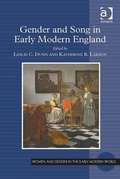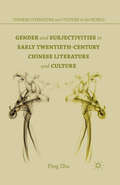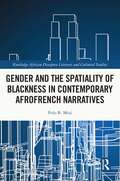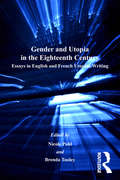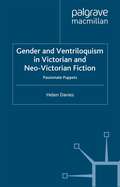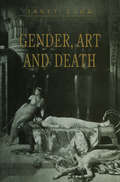- Table View
- List View
Gender and Song in Early Modern England
by Katherine R. Larson Leslie C. DunnSong offers a vital case study for examining the rich interplay of music, gender, and representation in the early modern period. This collection engages with the question of how gender informed song within particular textual, social, and spatial contexts in sixteenth- and seventeenth-century England. Bringing together ongoing work in musicology, literary studies, and film studies, it elaborates an interdisciplinary consideration of the embodied and gendered facets of song, and of song’s capacity to function as a powerful-and flexible-gendered signifier. The essays in this collection draw vivid attention to song as a situated textual and musical practice, and to the gendered processes and spaces of song's circulation and reception. In so doing, they interrogate the literary and cultural significance of song for early modern readers, performers, and audiences.
Gender and Song in Early Modern England (Women And Gender In The Early Modern World Ser.)
by Katherine R. Larson Leslie C. DunnSong offers a vital case study for examining the rich interplay of music, gender, and representation in the early modern period. This collection engages with the question of how gender informed song within particular textual, social, and spatial contexts in sixteenth- and seventeenth-century England. Bringing together ongoing work in musicology, literary studies, and film studies, it elaborates an interdisciplinary consideration of the embodied and gendered facets of song, and of song’s capacity to function as a powerful-and flexible-gendered signifier. The essays in this collection draw vivid attention to song as a situated textual and musical practice, and to the gendered processes and spaces of song's circulation and reception. In so doing, they interrogate the literary and cultural significance of song for early modern readers, performers, and audiences.
Gender And Song In Early Modern England (PDF)
by Leslie C. Dunn Katherine R. LarsonSong offers a vital case study for examining the rich interplay of music, gender, and representation in the early modern period. This collection engages with the question of how gender informed song within particular textual, social, and spatial contexts in sixteenth- and seventeenth-century England. Bringing together ongoing work in musicology, literary studies, and film studies, it elaborates an interdisciplinary consideration of the embodied and gendered facets of song, and of song's capacity to function as a powerful-and flexible-gendered signifier. The essays in this collection draw vivid attention to song as a situated textual and musical practice, and to the gendered processes and spaces of song's circulation and reception. In so doing, they interrogate the literary and cultural significance of song for early modern readers, performers, and audiences.
Gender and Space in British Literature, 1660-1820 (British Literature in Context in the Long Eighteenth Century)
by Mona Narain Karen GevirtzBetween 1660 and 1820, Great Britain experienced significant structural transformations in class, politics, economy, print, and writing that produced new and varied spaces and with them, new and reconfigured concepts of gender. In mapping the relationship between gender and space in British literature of the period, this collection defines, charts, and explores new cartographies, both geographic and figurative. The contributors take up a variety of genres and discursive frameworks from this period, including poetry, the early novel, letters, and laboratory notebooks written by authors ranging from Aphra Behn, Hortense Mancini, and Isaac Newton to Frances Burney and Germaine de Staël. Arranged in three groups, Inside, Outside, and Borderlands, the essays conduct targeted literary analysis and explore the changing relationship between gender and different kinds of spaces in the long eighteenth century. In addition, a set of essays on Charlotte Smith’s novels and a set of essays on natural philosophy offer case studies for exploring issues of gender and space within larger fields, such as an author’s oeuvre or a particular discourse. Taken together, the essays demonstrate space’s agency as a complement to historical change as they explore how literature delineates the gendered redefinition, occupation, negotiation, inscription, and creation of new spaces, crucially contributing to the construction of new cartographies in eighteenth- and early nineteenth-century England.
Gender and Space in British Literature, 1660-1820 (British Literature in Context in the Long Eighteenth Century)
by Mona Narain Karen GevirtzBetween 1660 and 1820, Great Britain experienced significant structural transformations in class, politics, economy, print, and writing that produced new and varied spaces and with them, new and reconfigured concepts of gender. In mapping the relationship between gender and space in British literature of the period, this collection defines, charts, and explores new cartographies, both geographic and figurative. The contributors take up a variety of genres and discursive frameworks from this period, including poetry, the early novel, letters, and laboratory notebooks written by authors ranging from Aphra Behn, Hortense Mancini, and Isaac Newton to Frances Burney and Germaine de Staël. Arranged in three groups, Inside, Outside, and Borderlands, the essays conduct targeted literary analysis and explore the changing relationship between gender and different kinds of spaces in the long eighteenth century. In addition, a set of essays on Charlotte Smith’s novels and a set of essays on natural philosophy offer case studies for exploring issues of gender and space within larger fields, such as an author’s oeuvre or a particular discourse. Taken together, the essays demonstrate space’s agency as a complement to historical change as they explore how literature delineates the gendered redefinition, occupation, negotiation, inscription, and creation of new spaces, crucially contributing to the construction of new cartographies in eighteenth- and early nineteenth-century England.
Gender and Space in Rural Britain, 1840–1920 (Warwick Series in the Humanities #3)
by Gemma Goodman Charlotte MathiesonThe essays in this collection focus on the ways rural life was represented during the long nineteenth century. Contributors bring expertise from the fields of history, geography and literature to present an interdisciplinary study of the interplay between rural space and gender during a time of increasing industrialization and social change.
Gender and Space in Rural Britain, 1840–1920 (Warwick Series in the Humanities)
by Charlotte Mathieson Gemma GoodmanThe essays in this collection focus on the ways rural life was represented during the long nineteenth century. Contributors bring expertise from the fields of history, geography and literature to present an interdisciplinary study of the interplay between rural space and gender during a time of increasing industrialization and social change.
Gender and Subjectivities in Early Twentieth-Century Chinese Literature and Culture (Chinese Literature and Culture in the World)
by P. ZhuThrough both cultural and literary analysis, this book examines gender in relation to late Qing and modern Chinese intellectuals, including Mu Shiying, Bai Wei, and Lu Xun. Tackling important, previously neglected questions, Zhu ultimately shows the resilience and malleability of Chinese modernity through its progressive views on femininity.
Gender and the Intersubjective Sublime in Faulkner, Forster, Lawrence, and Woolf (Among the Victorians and Modernists)
by Erin SpeeseExploring how the modern novel's complex depictions of parenthood restructure traditional conceptions of the Romantic sublime, Erin K. Johns Speese shows how William Faulkner, E.M. Forster, D.H. Lawrence, and Virginia Woolf use related strategies to rewrite the traditional sublime as an intersubjective experience. Speese shows that this reframing depends on the recognition of social objectification and an ethics of reciprocal empathy between mothers and fathers. She juxtaposes traditional aesthetics and Slavoj Žižek’s concept of the sublime object of ideology with recent theoretical work regarding identity, arguing that these modern novelists construct what she terms a "sublime subject," that is, a person who functions in the space of the traditional sublime object. In revealing the possibility of transcendent emotional connection over reason, these novelists critique the objectification of the other in favor of a sublime experience that reveals the subject-shattering power of empathy.
Gender and the Intersubjective Sublime in Faulkner, Forster, Lawrence, and Woolf (Among the Victorians and Modernists)
by Erin SpeeseExploring how the modern novel's complex depictions of parenthood restructure traditional conceptions of the Romantic sublime, Erin K. Johns Speese shows how William Faulkner, E.M. Forster, D.H. Lawrence, and Virginia Woolf use related strategies to rewrite the traditional sublime as an intersubjective experience. Speese shows that this reframing depends on the recognition of social objectification and an ethics of reciprocal empathy between mothers and fathers. She juxtaposes traditional aesthetics and Slavoj Žižek’s concept of the sublime object of ideology with recent theoretical work regarding identity, arguing that these modern novelists construct what she terms a "sublime subject," that is, a person who functions in the space of the traditional sublime object. In revealing the possibility of transcendent emotional connection over reason, these novelists critique the objectification of the other in favor of a sublime experience that reveals the subject-shattering power of empathy.
Gender and the Self in Latin American Literature (Routledge Transnational Perspectives on American Literature)
by Emma StanilandThis book explores six texts from across Spanish America in which the coming-of-age story ('Bildungsroman') offers a critique of gendered selfhood as experienced in the region’s socio-cultural contexts. Looking at a range of novels from the late twentieth century, Staniland explores thematic concerns in terms of their role in elucidating a literary journey towards agency: that is, towards the articulation of a socially and personally viable female gendered identity, mindful of both the hegemonic discourses that constrain it, and the possibility of their deconstruction and reconfiguration. Myth, exile and the female body are the three central themes for understanding the personal, social and political aims of the Post-Boom women writers whose work is explored in this volume: Isabel Allende, Laura Esquivel, Ángeles Mastretta, Sylvia Molloy, Cristina Peri Rossi and Zoé Valdés. Their adoption, and adaptation, of an originally eighteenth-century and European literary genre is seen here to reshape the global canon as much as it works to reshape our understanding of gendered identities as socially constructed, culturally contingent, and open-ended.
Gender and the Self in Latin American Literature (Routledge Transnational Perspectives on American Literature)
by Emma StanilandThis book explores six texts from across Spanish America in which the coming-of-age story ('Bildungsroman') offers a critique of gendered selfhood as experienced in the region’s socio-cultural contexts. Looking at a range of novels from the late twentieth century, Staniland explores thematic concerns in terms of their role in elucidating a literary journey towards agency: that is, towards the articulation of a socially and personally viable female gendered identity, mindful of both the hegemonic discourses that constrain it, and the possibility of their deconstruction and reconfiguration. Myth, exile and the female body are the three central themes for understanding the personal, social and political aims of the Post-Boom women writers whose work is explored in this volume: Isabel Allende, Laura Esquivel, Ángeles Mastretta, Sylvia Molloy, Cristina Peri Rossi and Zoé Valdés. Their adoption, and adaptation, of an originally eighteenth-century and European literary genre is seen here to reshape the global canon as much as it works to reshape our understanding of gendered identities as socially constructed, culturally contingent, and open-ended.
Gender and the Spatiality of Blackness in Contemporary AfroFrench Narratives (Routledge African Diaspora Literary and Cultural Studies)
by Polo B. MojiThis book approaches the study of AfroEurope through narrative forms produced in contemporary France, a location which richly illustrates race in European spaces. The book adopts a transdiciplinary lens that combines critical black and urban geographies, intersectional feminism, and textual analysis to explore the spatial negotiations of black women in France. It assesses literature, film, and music as narrative forms and engages with the sociocultural and political contexts from which they emerge. Through the figure of the black flâneuse and the analytical framework of "walking as method", the book goes beneath spectacular representations of ghettoised banlieues, televised protests, and shipwrecked migrants to analyse the spatiality of blackness in the everyday. It argues that the material-discursive framing of black flânerie, as both relational and embodied movements, renders visible a politics of place embedded in everyday mico-struggles of raced-sexed subjects. Foregrounding expressive modes and forms that have traditionally received little critical attention outside of the French and francophone world, this book will be relevant to academics, researchers, writers, students, activists, and readers with interests in Literary and Cultural Studies, African and Afrodiasporic Studies, Black Feminisms, Migration Studies, Critical Black Geographies, Francophone Studies, and the comparative framework of Afroeuropean Studies.
Gender and the Spatiality of Blackness in Contemporary AfroFrench Narratives (Routledge African Diaspora Literary and Cultural Studies)
by Polo B. MojiThis book approaches the study of AfroEurope through narrative forms produced in contemporary France, a location which richly illustrates race in European spaces. The book adopts a transdiciplinary lens that combines critical black and urban geographies, intersectional feminism, and textual analysis to explore the spatial negotiations of black women in France. It assesses literature, film, and music as narrative forms and engages with the sociocultural and political contexts from which they emerge. Through the figure of the black flâneuse and the analytical framework of "walking as method", the book goes beneath spectacular representations of ghettoised banlieues, televised protests, and shipwrecked migrants to analyse the spatiality of blackness in the everyday. It argues that the material-discursive framing of black flânerie, as both relational and embodied movements, renders visible a politics of place embedded in everyday mico-struggles of raced-sexed subjects. Foregrounding expressive modes and forms that have traditionally received little critical attention outside of the French and francophone world, this book will be relevant to academics, researchers, writers, students, activists, and readers with interests in Literary and Cultural Studies, African and Afrodiasporic Studies, Black Feminisms, Migration Studies, Critical Black Geographies, Francophone Studies, and the comparative framework of Afroeuropean Studies.
Gender and Utopia in the Eighteenth Century: Essays in English and French Utopian Writing
by Brenda TooleyFocusing on eighteenth-century constructions of symbolic femininity and eighteenth-century women's writing in relation to contemporary utopian discourse, this volume adjusts our understanding of the utopia of the Enlightenment, placing a unique emphasis on colonial utopias. These essays reflect on issues related to specific configurations of utopias and utopianism by considering in detail English and French texts by both women (Sarah Scott, Sarah Fielding, Isabelle de Charrière) and men (Paltock and Montesquieu). The contributors ask the following questions: In the influential discourses of eighteenth-century utopian writing, is there a place for 'woman,' and if so, what (or where) is it? How do 'women' disrupt, confirm, or ground the utopian projects within which these constructs occur? By posing questions about the inscription of gender in the context of eighteenth-century utopian writing, the contributors shed new light on the eighteenth-century legacies that continue to shape contemporary views of social and political progress.
Gender and Utopia in the Eighteenth Century: Essays in English and French Utopian Writing
by Brenda TooleyFocusing on eighteenth-century constructions of symbolic femininity and eighteenth-century women's writing in relation to contemporary utopian discourse, this volume adjusts our understanding of the utopia of the Enlightenment, placing a unique emphasis on colonial utopias. These essays reflect on issues related to specific configurations of utopias and utopianism by considering in detail English and French texts by both women (Sarah Scott, Sarah Fielding, Isabelle de Charrière) and men (Paltock and Montesquieu). The contributors ask the following questions: In the influential discourses of eighteenth-century utopian writing, is there a place for 'woman,' and if so, what (or where) is it? How do 'women' disrupt, confirm, or ground the utopian projects within which these constructs occur? By posing questions about the inscription of gender in the context of eighteenth-century utopian writing, the contributors shed new light on the eighteenth-century legacies that continue to shape contemporary views of social and political progress.
Gender and Ventriloquism in Victorian and Neo-Victorian Fiction: Passionate Puppets
by H. DaviesIs ventriloquism just for dummies? What is at stake in neo-Victorian fiction's desire to 'talk back' to the nineteenth century? This book explores the sexual politics of dialogues between the nineteenth century and contemporary fiction, offering a new insight into the concept of ventriloquism as a textual and metatextual theme in literature.
Gender and Violence in Historical and Contemporary Perspectives: Situating India
by Jyoti Atwal Iris FlessenkämperThis book covers a range of issues and phenomena around gender-related violence in specific cultural and regional conditions. Using an interdisciplinary approach, it discusses historical and contemporary developments that trigger violence while highlighting the social conditions, practices, discourses, and cultural experiences of gender-related violence in India. Beginning with the issues of gender-based violence within the traditional context of Indian history and colonial encounters, it moves on to explore the connections between gender, minorities, marginalisation, sexuality, and violence, especially violence against Dalit women, disabled women, and transgender people. It traces and interprets similarities and differences as well as identifies social causes of potential conflicts. Further, it investigates the forms and mechanisms of political, economic, and institutional violence in the legitimation or de-legitimation of traditional gender roles. The chapters deal with sexual violence, violence within marriage and family, influence of patriarchal forces within factory-based gender violence, and global processes such as demand-driven surrogacy and the politics of literary and cinematic representations of gender-based violence. The book situates relevant debates about India and underlines the global context in the making of the gender bias that leads to violence both in the public and private domains. An important contribution to feminist scholarship, this book will be useful to scholars and researchers of gender studies, women’s studies, history, sociology, and political science.
Gender and Violence in Historical and Contemporary Perspectives: Situating India
by Jyoti Atwal Iris FlessenkämperThis book covers a range of issues and phenomena around gender-related violence in specific cultural and regional conditions. Using an interdisciplinary approach, it discusses historical and contemporary developments that trigger violence while highlighting the social conditions, practices, discourses, and cultural experiences of gender-related violence in India. Beginning with the issues of gender-based violence within the traditional context of Indian history and colonial encounters, it moves on to explore the connections between gender, minorities, marginalisation, sexuality, and violence, especially violence against Dalit women, disabled women, and transgender people. It traces and interprets similarities and differences as well as identifies social causes of potential conflicts. Further, it investigates the forms and mechanisms of political, economic, and institutional violence in the legitimation or de-legitimation of traditional gender roles. The chapters deal with sexual violence, violence within marriage and family, influence of patriarchal forces within factory-based gender violence, and global processes such as demand-driven surrogacy and the politics of literary and cinematic representations of gender-based violence. The book situates relevant debates about India and underlines the global context in the making of the gender bias that leads to violence both in the public and private domains. An important contribution to feminist scholarship, this book will be useful to scholars and researchers of gender studies, women’s studies, history, sociology, and political science.
Gender and Voice in the French Novel, 1730–1782
by Aurora WolfgangAnalyzing four best-selling novels - by both women and men - written in the feminine voice, this book traces how the creation of women-centered salons and the emergence of a feminine poetic style engendered a new type of literature in eighteenth-century France. The author argues that writing in a female voice allowed writers of both sexes to break with classical notions of literature and style, so that they could create a modern sensibility that appealed to a larger reading public, and gave them scope to innovate with style and form. Wolfgang brings to light how the 'female voice' in literature came to embody the language of sociability, but also allowed writers to explore the domain of inter-subjectivity, while creating new bonds between writers and the reading public. Through examination of Marivaux's La Vie de Marianne, Graffigny's Lettres d'une Péruvienne, Riccoboni's Lettres de Mistriss Fanni Butlerd, and Laclos's Les Liaisons dangereuses, she shows that in France, this modern 'feminine' sensibility turned the least prestigious of literary genres - the novel - into the most compelling and innovative literary form of the eighteenth century. Emphasizing how the narratives analyzed here refashioned the French literary world through their linguistic innovation and expression of new forms of subjectivity, this study claims an important role for feminine-voice narratives in shaping the field of eighteenth-century literature.
Gender and Voice in the French Novel, 1730–1782
by Aurora WolfgangAnalyzing four best-selling novels - by both women and men - written in the feminine voice, this book traces how the creation of women-centered salons and the emergence of a feminine poetic style engendered a new type of literature in eighteenth-century France. The author argues that writing in a female voice allowed writers of both sexes to break with classical notions of literature and style, so that they could create a modern sensibility that appealed to a larger reading public, and gave them scope to innovate with style and form. Wolfgang brings to light how the 'female voice' in literature came to embody the language of sociability, but also allowed writers to explore the domain of inter-subjectivity, while creating new bonds between writers and the reading public. Through examination of Marivaux's La Vie de Marianne, Graffigny's Lettres d'une Péruvienne, Riccoboni's Lettres de Mistriss Fanni Butlerd, and Laclos's Les Liaisons dangereuses, she shows that in France, this modern 'feminine' sensibility turned the least prestigious of literary genres - the novel - into the most compelling and innovative literary form of the eighteenth century. Emphasizing how the narratives analyzed here refashioned the French literary world through their linguistic innovation and expression of new forms of subjectivity, this study claims an important role for feminine-voice narratives in shaping the field of eighteenth-century literature.
Gender and warfare in the twentieth century: Textual representations
by Angela K. SmithGender and warfare in the twentieth century' is a collection of essays that explores the way in which issues of gender impacted upon twentieth-century warfare. A range of specialist contributors provide exciting, accessible and very readable essays covering a range of wars and textual media.
Gender, Art and Death
by Janet ToddIn this book, Janet Todd, one of the leading authorities on seventeenth- and eighteenth century women writers, discusses gender issues from the Restoration to Romanticism investigating women authors and the fascination with culturally privileged art and with heroic death.
Gender, Art and Death
by Janet ToddIn this book, Janet Todd, one of the leading authorities on seventeenth- and eighteenth century women writers, discusses gender issues from the Restoration to Romanticism investigating women authors and the fascination with culturally privileged art and with heroic death.
Gender Articulated: Language and the Socially Constructed Self
by Kira Hall Mary BucholtzGender Articulated is a groundbreaking work of sociolinguistics that forges new connections between language-related fields and feminist theory. Refuting apolitical, essentialist perspectives on language and gender, the essays presented here examine a range of cultures, languages and settings. They explicitly connect feminist theory to language research. Some of the most distinguished scholars working in the field of language and gender today discuss such topics as Japanese women's appropriation of "men's language," the literary representation of lesbian discourse, the silencing of women on the Internet, cultural mediation and Spanish use at New Mexican weddings and the uses of silence in the Anita Hill-Clarence Thomas hearings.

